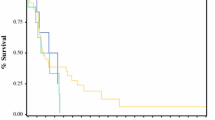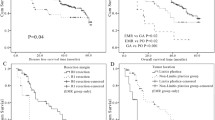Abstract
Background
The prognosis of patients with linitis plastica (LP) gastric cancer is reported to be poor. The purpose of our retrospective study was to characterize the clinicopathologic features and survival outcomes of patients with LP, using a univocal definition.
Methods
We defined LP as gastric cancer that involves more than 1/3 of the gastric wall macroscopically. We reviewed a prospectively maintained institutional database of gastric cancer patients and summarized and compared clinicopathologic factors of patients with and without LP who had undergone gastrectomy. Patients were matched 1:1 using propensity score matching, and their overall survival (OS) rates and durations were compared. Multivariable Cox regression analyses were conducted, using gastrectomy as a time-varying covariate.
Results
We identified 740 patients with radiographically non-metastatic gastric cancer, 157 (21.2%) of whom had LP. Most patients with LP had advanced-stage disease (75.8% had stage IV disease, mainly due to peritoneal involvement). Patients with LP had significantly shorter OS durations than did those without LP in the entire cohort (median OS, 14.0 vs. 33.5 months; p value < 0.001) and in the surgical cohort (median OS after gastrectomy, 21.8 vs. 91.0 months; p < 0.001), as well as in the propensity-matched surgical cohort. In the LP cohort, chemotherapy (hazard ratio [HR] = 0.594; p = 0.076), chemoradiation therapy (HR = 0.346; p = 0.001), and gastrectomy (HR = 0.425; p = 0.003) were associated with a longer OS.
Conclusions
LP is a phenotype of gastric cancer that often presents at an advanced stage, with a high rate of peritoneal involvement. The survival durations of patients with LP were poor in our study, even in the surgical cohort. The use of preoperative chemotherapy, chemoradiation therapy, and gastrectomy appeared to be important in carefully selected patients with localized LP.


Similar content being viewed by others
References
Ferlay J, Soerjomataram I, Ervik M. GLOBOCAN, cancer incidence and mortality worldwide: IARC cancer base no. 11 [Internet]. Lyon, France: International Agency for Research on Cancer; 2013. 2012.
Piessen G, Messager M, Leteurtre E, Jean-Pierre T, Mariette C. Signet ring cell histology is an independent predictor of poor prognosis in gastric adenocarcinoma regardless of tumoral clinical presentation. Ann Surg. 2009;250(6):878-887.
Jafferbhoy S, Shiwani H, Rustum Q. Managing gastric linitis plastica: keep the scalpel sheathed. Sultan Qaboos Univ Med J. 2013;13(3):451-453.
Blackham AU, Swords DS, Levine EA, et al. Is Linitis Plastica a Contraindication for Surgical Resection: A Multi-Institution Study of the U.S. Gastric Cancer Collaborative. Annals of surgical oncology. 2016;23(4):1203-1211.
Schauer M, Peiper M, Theisen J, Knoefel W. Prognostic factors in patients with diffuse type gastric cancer (linitis plastica) after operative treatment. European journal of medical research. 2011;16(1):29-33.
Mastoraki A, Papanikolaou IS, Sakorafas G, Safioleas M. Facing the challenge of managing linitis plastica--review of the literature. Hepato-gastroenterology. 2009;56(96):1773-1778.
Otsuji E, Kuriu Y, Okamoto K, et al. Outcome of surgical treatment for patients with scirrhous carcinoma of the stomach. American journal of surgery. 2004;188(3):327-332.
Endo K, Sakurai M, Kusumoto E, et al. Biological significance of localized Type IV scirrhous gastric cancer. Oncol Lett. 2012;3(1):94-99.
Japanese Gastric Cancer A. Japanese gastric cancer treatment guidelines 2014 (ver. 4). Gastric cancer : official journal of the International Gastric Cancer Association and the Japanese Gastric Cancer Association. 2017;20(1):1-19.
Agnes A, Estrella JS, Badgwell B. The significance of a nineteenth century definition in the era of genomics: linitis plastica. World journal of surgical oncology. 2017;15(1):123.
Iwasaki Y, Sasako M, Yamamoto S, et al. Phase II study of preoperative chemotherapy with S-1 and cisplatin followed by gastrectomy for clinically resectable type 4 and large type 3 gastric cancers (JCOG0210). Journal of surgical oncology. 2013;107(7):741-745.
Hartgrink HH. Improving outcome for scirrhous gastric cancer. Gastric cancer : official journal of the International Gastric Cancer Association and the Japanese Gastric Cancer Association. 2009;12(1):3-5.
Kodera Y, Ito S, Mochizuki Y, et al. The number of metastatic lymph nodes is a significant risk factor for bone metastasis and poor outcome after surgery for linitis plastica-type gastric carcinoma. World journal of surgery. 2008;32(9):2015-2020.
Kodera Y, Nakanishi H, Ito S, et al. Detection of disseminated cancer cells in linitis plastica-type gastric carcinoma. Japanese journal of clinical oncology. 2004;34(9):525-531.
Hamy A, Letessier E, Bizouarn P, et al. Study of survival and prognostic factors in patients undergoing resection for gastric linitis plastica: a review of 86 cases. International surgery. 1999;84(4):337-343.
Pedrazzani C, Marrelli D, Pacelli F, et al. Gastric linitis plastica: which role for surgical resection? Gastric cancer : official journal of the International Gastric Cancer Association and the Japanese Gastric Cancer Association. 2012;15(1):56-60.
Aranha GV, Georgen R. Gastric linitis plastica is not a surgical disease. Surgery. 1989;106(4):758-762; discussion 762-753.
Thompson RJ, Ranaghan L, Kennedy R, Clements W, Carey PD, Kennedy JA. Survival following operative management of gastric linitis plastica compared with non-operative management. Annals of the Royal College of Surgeons of England. 2016:1-5.
Burgain C, Germain A, Bastien C, et al. Computed tomography features of gastrointestinal linitis plastica: spectrum of findings in early and delayed phase imaging. Abdom Radiol (NY). 2016;41(7):1370-1377.
Edge S, Byrd D, Compton C, Fritz A, Greene F, Trotti A. Stomach. AJCC Cancer Staging Book 7th ed Berlin: Springer. 2010:145-152.
Badgwell B, Ajani J, Blum M, et al. Postoperative Morbidity and Mortality Rates are Not Increased for Patients with Gastric and Gastroesophageal Cancer Who Undergo Preoperative Chemoradiation Therapy. Annals of surgical oncology. 2016;23(1):156-162.
Badgwell B, Blum M, Estrella J, et al. Predictors of Survival in Patients with Resectable Gastric Cancer Treated with Preoperative Chemoradiation Therapy and Gastrectomy. Journal of the American College of Surgeons. 2015;221(1):83-90.
Badgwell B, Blum M, Elimova E, et al. Frequency of Resection After Preoperative Chemotherapy or Chemoradiotherapy for Gastric Adenocarcinoma. Annals of surgical oncology. 2016;23(6):1948-1955.
Ikoma N, Blum M, Estrella JS, et al. Left Gastric Artery Lymph Nodes Should Be Included in D1 Lymph Node Dissection in Gastric Cancer. Journal of gastrointestinal surgery : official journal of the Society for Surgery of the Alimentary Tract. 2017.
Ikoma N, Blum M, Chiang YJ, et al. Yield of Staging Laparoscopy and Lavage Cytology for Radiologically Occult Peritoneal Carcinomatosis of Gastric Cancer. Annals of surgical oncology. 2016;23(13):4332-4337.
Ikoma N, Blum M, Chiang YJ, et al. Survival rates in T1 and T2 gastric cancer: A Western report. Journal of surgical oncology. 2016;114(5):602-606.
Ikoma N, Blum M, Estrella JS, et al. Evaluation of the American Joint Committee on Cancer 8th edition staging system for gastric cancer patients after preoperative therapy. Gastric cancer : official journal of the International Gastric Cancer Association and the Japanese Gastric Cancer Association. 2017.
Ikoma N, Chen HC, Wang X, et al. Patterns of Initial Recurrence in Gastric Adenocarcinoma in the Era of Preoperative Therapy. Annals of surgical oncology. 2017;24(9):2679-2687.
John P. Klein MLM. Survival Analysis: Techniques for Censored and Truncated Data (Statistics for Biology and Health). Springer; 2005.
Tsujitani M, Tanaka Y. Analysis of heart transplant survival data using generalized additive models. Comput Math Methods Med. 2013;2013:609857.
Rosenbaum PR, Rubin DB. The central role of the propensity score in observational studies for causal effects. Biometrika. 1983;70(1):41-55.
Austin PC. The use of propensity score methods with survival or time-to-event outcomes: reporting measures of effect similar to those used in randomized experiments. Statistics in medicine. 2014;33(7):1242-1258.
Thoemmes F. Propensity score matching in SPSS. arXiv preprint arXiv:12016385. 2012.
Thiels CA, Ikoma N, Fournier K, et al. Repeat staging laparoscopy for gastric cancer after preoperative therapy. Journal of surgical oncology. 2018;118(1):61-67.
Terai S, Fushida S, Tsukada T, et al. Bone marrow derived “fibrocytes” contribute to tumor proliferation and fibrosis in gastric cancer. Gastric cancer : official journal of the International Gastric Cancer Association and the Japanese Gastric Cancer Association. 2015;18(2):306-313.
Naito Y, Sakamoto N, Oue N, et al. MicroRNA-143 regulates collagen type III expression in stromal fibroblasts of scirrhous type gastric cancer. Cancer science. 2014;105(2):228-235.
Dvorak HF. Tumors: wounds that do not heal-redux. Cancer immunology research. 2015;3(1):1-11.
Acknowledgments
We thank the Department of Scientific Publications at MD Anderson for editorial assistance.
Funding
This study was supported in part by the National Institutes of Health under award number P30 CA016672 and by the Clinical Trials Support Resource.
Author information
Authors and Affiliations
Corresponding author
Ethics declarations
Conflict of Interest
The authors declare that they have no conflicts of interest.
Additional information
Publisher’s Note
Springer Nature remains neutral with regard to jurisdictional claims in published maps and institutional affiliations.
Rights and permissions
About this article
Cite this article
Ikoma, N., Agnes, A., Chen, HC. et al. Linitis Plastica: a Distinct Type of Gastric Cancer. J Gastrointest Surg 24, 1018–1025 (2020). https://doi.org/10.1007/s11605-019-04422-7
Received:
Accepted:
Published:
Issue Date:
DOI: https://doi.org/10.1007/s11605-019-04422-7




